Exeter - The Cathedral City
by Clayton Trapp
Exeter is dominated, historically and geographically, by the
Cathedral of St Peter. The cathedral is elevated on a hill and
so can be seen from virtually anywhere for miles around. It
pokes out from every street corner and, because the city's street
plan has evolved in a rather entropic and angular manner, gives
the illusion of moving around.
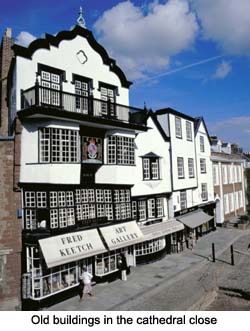 The cathedral is among the three or four most famous
in the kingdom and few visitors leave town without the full tour,
and catching their breath a few times at the sheer beauty and
otherworldly presence of the structure. Unlike other attractions
of its magnitude, I've never heard anyone express disappointment
upon experiencing Exeter's Cathedral of St Peter. The cathedral is among the three or four most famous
in the kingdom and few visitors leave town without the full tour,
and catching their breath a few times at the sheer beauty and
otherworldly presence of the structure. Unlike other attractions
of its magnitude, I've never heard anyone express disappointment
upon experiencing Exeter's Cathedral of St Peter.
Unfortunately many visitors focus on the cathedral at the expense
of everything else. Exeter has the wealth of history that one
would expect from a jewel at various times times plucked, or at
least attacked, by the Romans, Saxons, Normans, Vikings, Nazis
and a host of internal revolutionary groups during and after the
Wars of the Roses.
Historians generally agree that a settlement in what is now
Exeter predates the Roman invasion. Ancient rumour holds that
Exeter's famous walls, much of which still stand, were
instrumental in repelling the Roman Emperor Vespasian in the
first century. Thus thwarted, Vespasian then turned his
attentions more successfully on Jerusalem.
Historians tend toward the opinion that Exeter's walls were not
built until the end of the second century, by the Romans who
played a key role in establishing Exeter by setting up a garrison
on the hill where the cathedral now stands (around 50 AD). Thus
satiated, and after naming the town Isca, Vespasian moved on.
In either event, Vespasian was hardly the last of the invaders,
and the walls saw plenty of action. By the 20th century,
however, they were obsolete as Nazi bombers simply flew over
them, dropping loads that demolished High Street and clipped the
cathedral.
Nazi destruction gave rise to a post-war architectural
renaissance. Today new mixes with old as neon cafés and
surf shops mingle with ancient pubs and cobblestone in the
shadows of the cathedral and protective walls. A new shopping
development in Princesshay will add a space age Californian
sensibility to the aesthetic mélange of the downtown area.
As an added bonus for the traveller, everything you want to see
is within easy walking distance.
The Cathedral
 However spectacular the Princesshay development may
turn out to be, no pseudo-mall is ever going to replace the
Cathedral of St Peter in the hearts or minds of the locals or
visitors. The cathedral has stood for nearly one thousand years
and enjoys beauty and spiritual qualities that would make it
appealing even if it had been built yesterday. It is a structure
of those qualities that are simply impossible to relate in the
absence of experiencing them first hand. However spectacular the Princesshay development may
turn out to be, no pseudo-mall is ever going to replace the
Cathedral of St Peter in the hearts or minds of the locals or
visitors. The cathedral has stood for nearly one thousand years
and enjoys beauty and spiritual qualities that would make it
appealing even if it had been built yesterday. It is a structure
of those qualities that are simply impossible to relate in the
absence of experiencing them first hand.
Christians worshipped near the site of the cathedral during Roman
times, and a monastery (where St Boniface was schooled) was built
around on the grounds around 1040. A decade later Edward the
Confessor transferred the see of Crediton to Exeter, thereby
setting off speculation as to the adequacy of the monastery for
its expanded role.
The third Bishop of Exeter, William Warelwast (nephew of William
the Conqueror, who had taken Exeter in 1068) quashed the
speculants by beginning work on a mighty cathedral to replace the
monastery, around 1110. Warelwast's vision took fifty years to
realize, but satisfied the powers that be for only about 200
years. In 1260 the cathedral was demolished, with the exception
of its two Norman towers, with the cathedral as we now know it
taking shape over the succeeding 130 years.
Warelwast's contribution should not be quickly dismissed. The
Norman towers -- St Paul's on the north and St John's to the
south -- define the cathedral from a distance, and are certainly
among the most inspiring aspects of the cathedral. St John's
tower also now houses a peal of 14 bells, and St Paul's the
extraordinary four ton bell donated by Bishop Peter Courtenay in
1484. It is Courtenay's bell that still marks the hour, sending
reverberations down the River Exe and off into the
countryside.
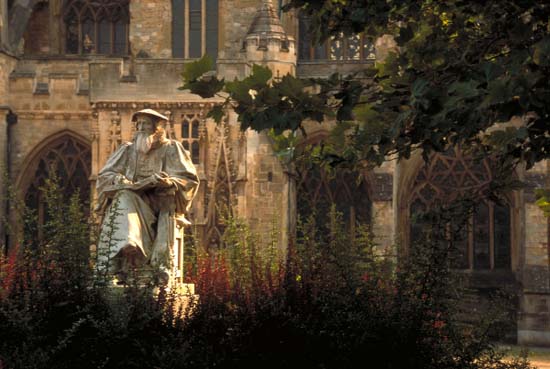
A visitor's impression of the majestic towers is immediately
confirmed by a few minutes at the west front of the cathedral.
It is here that visitors and parishioners enter the church, but
no one can ever go straight in! The stone work is simply
incredible, and though some has deteriorated slightly to the
years (the west front assumed its current glory during the
mid-14th century) what remains is really too wonderful to
imagine.
Figures stand out on the west front like a roll call from heaven
itself. The top tier of 28 ecclesiastical figures finds Jesus
fifteenth from the left. William the Conqueror occupies a place
of honour in the middle row, dedicated to kings, and a bottom row
of angels -- many playing musical instruments -- support their
earthly allies. Sadly the key to identifying all of the figures
has apparently been lost.
Entering the cathedral is no less inspiring than standing
outside. The longest unbroken stretch (68 feet, 21 meters) of
Gothic vaulting in the world stretches above the nave floor, to
which it is connected by thirty 14th century columns of Purbeck
marble. The vaulting is complemented by decorative pieces
depicting biblical and historical scenes, perhaps the most
striking of which is the murder of Thomas Becket in Canterbury
Cathedral (one of Exeter's few "rival cathedrals" in
terms of tourism).
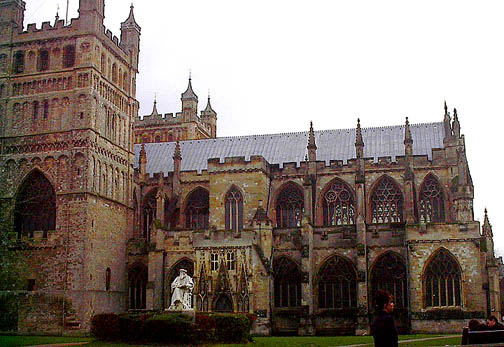
Cathedral aficionados are invariably impressed by the minstrel's
gallery on the south side of the nave, where twelve sculpted
angels can be found playing 14th century musical instruments.
Sadly one of the angels lost their instrument at some point along
the way, but it's difficult to imagine that such a thing would
amount to much of a setback to an angel. On Christmas Day the
church choir sings from a room behind the gallery, reminding the
faithful of our potential to follow the example of the
sacred.
Entire books have been written on the cathedral but no
consideration could have any semblance of authority without
mentioning the 15th century astrological clock that depicts the
orbit of the sun (represented as a fleur-de-lys) and moon around
the earth. The clock also tells time, somewhat more accurately
than it demonstrates the movements of celestial bodies, and is
said to have inspired the lyric poem "Hickory Dickory
Dock."
In fact, for all of the cathedral's historic grandeur, elements
of the humorous and bizarre abound. One of the 13th century
misericords, found below the choir stalls, is, for example,
decorated with an elephant. That might be notable in its own
right, but this particular elephant is the work of a master
craftsman whose experience was no doubt broad but did not include
ever personally engaging in any way with an elephant. The result
is a profoundly expressive creature with tusks, but one who also
sports expansive hooves of a nature to make any team of
racehorses jealous.
A visit to the cathedral is certain to be a dramatic event under
any weather or circumstance. The power of the cathedral is such
that any storm could only play a supporting role, and insider's
swear by sensations brought on by the falling sun's illumination
filtered through the great west window onto the cathedral's
pillars, vaults and tombs.
Exeter is said to be Britain's most haunted city, and such lore
couldn't possibly be complete without such goings-on in and
around the cathedral. The ghost of a past caretaker, whose love
of the cathedral was nearly legendary in itself, has been
witnessed in one of the chapels on several occasions. On warm
July evenings the ghost of a nun has been seen floating about the
south wall of the nave, several times over the years.
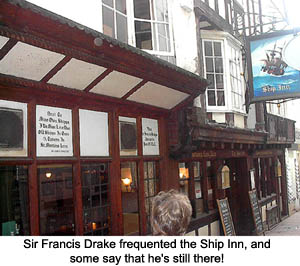 Finally it must be said that Exeter's cathedral is a
working church. The pious, or curious, can select from five
services on any Sunday, four services on weekdays, and a number
of special events throughout the year. Finally it must be said that Exeter's cathedral is a
working church. The pious, or curious, can select from five
services on any Sunday, four services on weekdays, and a number
of special events throughout the year.
The area surrounding the cathedral is historic in its own,
somewhat different, right. Cathedral Close wouldn't be a bad
subject of an essay, and the truth is that the saltiest dogs of
the seagoing epoch found their pleasure in the area within a
stone's throw of the Norman towers. The Close was also the point
of departure for Jonathan Harker's trip to Transylvania in Bram
Stoker's "Dracula." [For a related article, see Whitby: Town of Voyagers and
Vampires, by Jane Gilbert.]
No less than Sir Francis Drake declared the nearby Ship Inn to be
his favourite place on earth, with the obvious exception of his
own ship. It is said that Sir Drake enjoyed the environs of the
Ship Inn to such a degree that management determined that his
visits would be welcome only on those occasions that the
legendary explorer was accompanied by "a responsible
person." At the time Drake was said to be in something akin
to agreement, but in the intervening years the great man's ghost
has been blamed for a great deal of havoc at the pub including
pushing people down a flight of stairs.
The Quay
About ten minutes by foot from the cathedral, Exeter's quay is
hardly comparable to New York's harbor, or even Seaport Village
in San Diego, and therein lies much of its charm. The quay is a
clever echo of an age gone past, replete with nice food and shops
and no small amount of history if you look upon the scene with
proper eyes.
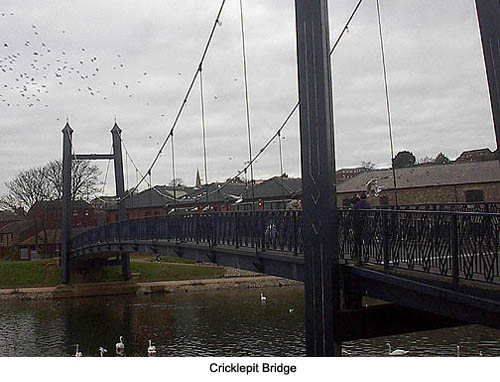
In the early days, going back to Roman times, trade was conducted
on the River Exe. The river is not particularly immense,
however, and so goods had to be transferred on the wider portions
of the river, which weren't as far inland as merchants would have
liked. To make matters even more difficult a series of Earls of
Devon conducted economic battles with the city in efforts to
collect taxes.
The Earls were outraged that commerce flowed even as smoothly as
it did -- instead of ships importing needed goods, they saw taxes
just flowing by and getting away. A weir was built, impeding
traffic on the Exe but ensuring taxation.
For more than one hundred years (1335-1461) the Courtenays
(Earls) controlled commerce, and everything else, in the area,
unchallenged as favourites of the monarchy. In 1461, however,
Thomas Courtenay apparently misplayed a point, and was beheaded
by the king.
The loyal citizens of Exeter immediately petitioned the crown for
their rights to fish in and navigate the waters of the Exe, but
the king was apparently too busy for such trifles and failed to
respond. Nothing changed.
The wool trade became Exeter's primary industry and the
Courtenay's taxed it enthusiastically. Perhaps the Courtenays
were a restless dynasty, but whatever the case Henry Courtenay
was beheaded for treason in 1539.
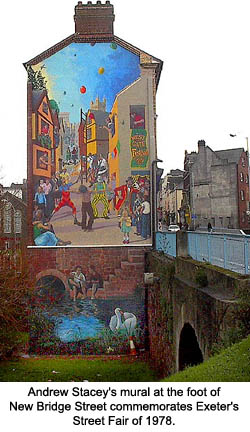 Now
troubled by the necessity of having had to behead two Courtenay's
in only 70 years, the king finally granted the city permission to
make the river more easily navigable again. Unfortunately the
weir had created an imposing silt buildup. Now
troubled by the necessity of having had to behead two Courtenay's
in only 70 years, the king finally granted the city permission to
make the river more easily navigable again. Unfortunately the
weir had created an imposing silt buildup.
The decision was made to build a canal, and Exeter's churches
were among the leading economic contributors. Just when things
looked to be going smoothly Exeter was shaken to its foundations,
and put under siege, during the Prayer Book Revolt of 1549.
Fortunately the prayer book disagreements were resolved after a
scant fourteen years, and the minds of the day again turned their
attention to the canal.
The canal leading to the quay was the first in England to use
pound locks, and opened to shipping in 1566. The world was a
simpler place then, and the great ships weighed anchor at sea,
sending lighter boats filled with goods through the canal,
typically pulled by hand or horse. Taxes on trade through the
canal were sometimes levied, but often forgotten.
By the mid 17th century the canal was in disrepair and Exeter's
increasing population was stretching the water supply in all the
usual ways. Dramatic action was obviously needed, and Richard
Hurd of Cardiff stepped forward to dredge the canal for the
rather reasonable fee of £100. Hurd's efforts were
accompanied by the creation of a canal extension making it
possible for larger ships (to 60 tons) to take advantage of the
trade opportunities offered by the quay.
Of course progress moved quickly, and a mere fifty years later a
decision was made to further enlarge the canal. The major
project was entrusted to an engineer, William Bayley, who
promptly made off with the loot, bringing work to a decidedly
sudden stop. Dejected but not defeated, the Chamber raised money
for the project through loans and the canal was once again
elevated to cutting-edge status (now 300 ton ships were arriving
at the quay).
Sadly, the shipbuilders just kept making them larger and larger
and by the mid 19th century the quay had been effectively
relegated to historical remnant status. Its final gasps were in
terms of flooding, and a flood of ship owners presenting bills
for their losses to local government.
Today the quay and canal remain, dotted with pub umbrellas and
gift shops. The area picks up in the summer but is never
oppressively crowded. Bridges (including the venerable
Cricklepit Bridge) and wooded areas make the canal an excellent
area for walks, Alternately, canoes are available for hire.
The single funnest thing to do at the quay, though, is to take a
ride on Butt's Ferry. The ferry is named after George Butt, who
valiantly battled in the 1970s against the City Council, who had
the lack of vision to consider the ferry too expensive to operate
(passage costs approximately the same amount as a brief local
telephone call).
In the council's defense it must be admitted that the ferry
crosses the canal at a point where... well, you could easily
throw a rock across it, or swim across in a matter of two or
three minutes, but that isn't the point. It's as fun as it is
silly.
The ferry (summertime only) operates through a rather unique
system whereby the ferryman propels the miniature barge, holding
perhaps four passengers, across the canal by means of locomotion
generated by his pulling along a wire linking the two sides of
the canal. Fewer ferries get lost that way, you see, and the
petrol bill remains lower.
The Guildhall
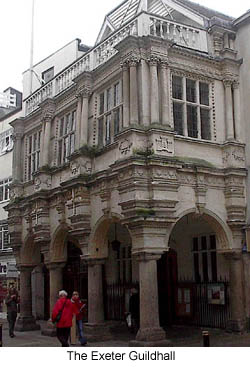 Exeter's Guildhall is the oldest in the kingdom, dating
back to 1160. Of course improvements have been made since then
and so it's unlikely that any of the Guildhall that you see on
High Street dates further back than 1330. The four granite
pillars of the Tudor Portico (installed for a reasonable
£782), supporting the Mayor's Parlour (previously the
chapel), are recent additions that date back a mere 400
years. Exeter's Guildhall is the oldest in the kingdom, dating
back to 1160. Of course improvements have been made since then
and so it's unlikely that any of the Guildhall that you see on
High Street dates further back than 1330. The four granite
pillars of the Tudor Portico (installed for a reasonable
£782), supporting the Mayor's Parlour (previously the
chapel), are recent additions that date back a mere 400
years.
The Guildhall was the center of commerce in the early days. The
council met in the Great Chamber, and four special benches marked
off an area designated as the court. Anyone, or any business
taking place, within the confines of the benches was considered
as being, or done, "in court."
By Tudor times the Guildhall had evolved from being strictly a
commercial center, to include entertainment. The King's Players,
or Queen's Players, came through with an eagerly awaited play
each year, and numerous other plays and musical events kept the
mood of the city festive.
The Guildhall remained the hub of much local government
bureaucracy, and as such couldn't help but be a focal point of
the Prayer Book Revolt of 1549. Proponents and opponents of the
new English-language book plotted and seethed, with defections
celebrated and lamented, until the Guildhall literally came under
siege in the midst of bureaucratic mutiny. In fairness to both
sides precious little harm came to the Guildhall, perhaps due to
the plethora of prayers proceeding from both camps of
combatants.
The Guildhall still houses bureaucrats, music, and theatre, and a
museum has been added. Highlights of the museum include the
sword and hat of maintenance (rewards from King VII for Exeter's
loyalty in seeing off a challenge to the throne by a Dutchman,
Perkin Warbeck, with a penchant for claiming to be, among other
things, the bastard son of Richard III or alternately Edward IV's
nephew, the Earl of Warwick), and various chains and maces and
silver objects.
Against all odds there have been no recordings of ghostly
activities in the Guildhall proper. Next door, however, in the
building now housing Ernest Jones, Jewellers, a female ghost has
been known to rush towards patrons before suddenly vanishing,
repeatedly set off the fire alarm, and knock over items too
numerous to mention. This latter activity has earned the moniker
of "Exeter's Clumsiest Ghost."
On the south side the Guildhall is flanked by the Turk's Head, a
pub frequented by Charles Dickens in his day. It is said that
Dickens conceived the Fat Boy of Pickwick Papers, and
Martin Chuzzlewit, amid pints of ale consumed here. Visitors are
encouraged to try their own luck whilst imbibing in the
"Dickens Corner" of the pub.
The Underground Passages
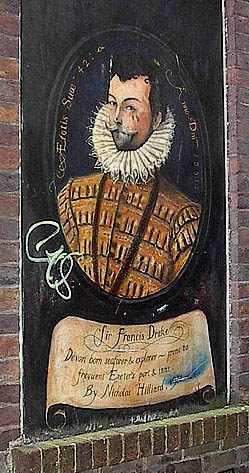 Exeter's underground passages are proof positive that
you can never tell what succeeding generations are going to find
interesting. They were excavated beginning in the mid-12th
century for the entirely utilitarian purpose of simplifying work
on the city water system. In the years since they have been
linked with buried treasure, secret escape routes, subterranean
religious activity, and a ghost on a bicycle. Exeter's underground passages are proof positive that
you can never tell what succeeding generations are going to find
interesting. They were excavated beginning in the mid-12th
century for the entirely utilitarian purpose of simplifying work
on the city water system. In the years since they have been
linked with buried treasure, secret escape routes, subterranean
religious activity, and a ghost on a bicycle.
The history of a water system is rarely as exciting as an
underground passage, but the tale of Exeter's water supply is
hardly, um, dry. At one point the same workmen who created the
exquisite west front of Exeter's historic cathedral were
commended for their work and promptly sent underground to dig the
passages. Payment was slight, in accordance with the tradition
of the day, but included princely quantities of ale.
The underground passage system became expansive, and was
considered a source of vulnerability during the English Civil War
in 1642. Portions of the passages were blocked off and
subsequently collapsed. For more than ten years the entire
system was useless, but was repaired in 1655 with the cessation
of hostilities.
Exeter's rapidly increasing population (a whopping 15,000 by the
end of 1699) stretched the system, and led to the successful
search for alternate delivery systems.
Nonetheless, the venerable passage system continued to be part of
the solution until the cholera outbreak of 1832. Exeter's slums
were hardest hit, with hundreds dying during the first months of
the outbreak. To their credit local government responded quickly
and with all of the resources that they had, and when it became
apparent that the underground water system was a source of the
disease it was permanently shut down.
Today Exeter's underground sandstone passages present as
something considerably more dramatic than a water system. No
similar passages can be found in England, and they simply demand
all of the myths that have grown around them. The oldest
accessible parts of the passages date from the mid 14th century
and visitors are warned that vaulting can be low, floors uneven,
and passages constricted.
More to See...
The House that Moved. Stepcote Hill. It's only a small
Tudor (1471) timber-framed house -- one room wide but three
stories high -- but Tuckers Hall created quite the international
sensation when it was threatened by road expansion in 1961. The
faithful rallied and the house was eventually put on rollers and
rolled to its current place of rest, a full 70 meters (75 yards)
from the original. Located approximately midway between the
cathedral and quay, just ask any local where to find "the
house that moved."
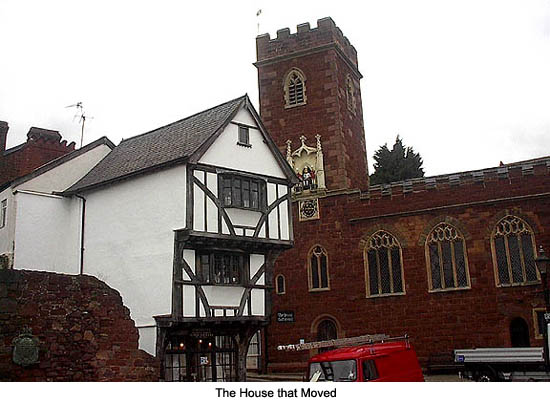
Mile End Cottage. Church Road, Alphington. Several
miles south of everything else you'd like to see in Exeter, but
well worth the trip for Charles Dickens fans. The beloved writer
rented the cottage primarily to keep his father from getting into
trouble in London, but after four years the elder Dickens tired
of the lack of temptation presented by the (then) countryside.
Charles Dickens visited his parents regularly at Mile End
Cottage, and wrote the opening chapters of "Nicholas
Nickleby" there. The landlady was the inspiration for the
character of Mrs Lupin the Blue Dragon in "Martin
Chuzzlewit. The cottage is now a private residence, but you're
welcome to read the plaque outside.
Best Place for a pint: The Royal Oak Public House. 68
Okehampton Street. (01392) 255665. Located a 15 minute walk and
just across the River Exe from the Cathedral, the Royal Oak is
one of those perfect old British pubs. The interior is warm and
wooden and bereft of pretense. The regulars are friendly, but
happy enough to leave you alone if you prefer. On sunny days you
can sip local Otter Ale on the deck overlooking the river,
lording over the procession of joggers and dogs along the
footpath below.
Best Place for dinner: The Old Times Wine Bar &
Restaurant. Little Castle Street. (01392) 477704. Located in an
alley, about three minutes walk from the Cathedral, the Old Times
offers a bar decorated in a highly spirited and eclectic manner
(lots of wood, a giant model airplane, old advertisements,
thousands of items), and outstanding pub food. Stilton Glazed
Garlic Mushrooms and the Bacon and Brie Ciabatta are recommended.
Upstairs things are a bit fancier without entirely losing the
casual feel, but still reasonably priced. The steaks are said to
be Exeter's best, and other options include Italian specialty
dishes and Hickory Ribs that make ordering automatic for my
wife.
Red Coat Guide Tours: (01392) 265203. Various guided
tours of Exeter (Medieval, Roman, Cathedral to Quay, Ghosts and
Legends, etc) are available free of charge, and year round. No
booking is required.
Related Articles:
- Exeter Timeline, by Darcy Lewis
- https://www.timetravel-britain.com/articles/towns/extime.shtml
- A Taste of Devon: Clotted Cream, Splits, Scrumpy and Gin, by Dawn Copeman
- https://www.timetravel-britain.com/articles/taste/taste06.shtml
More Information:
We regret that we no longer have the resources to maintain up-to-date links and/or hours and pricing details for the various sites and attractions listed on this website. For more information about the location(s) listed above, please use your favorite search engine or visit Wikipedia.
Clayton Trapp is the author of the novel Snap Once, a
series of children's books, and several nonfiction
works. He lives in Exeter with his wife, four
children, and a gloriously obstinate dog named Laural.
Article and photos © 2006 Clayton Trapp
(Top three photos courtesy of Britainonview.com)
| 